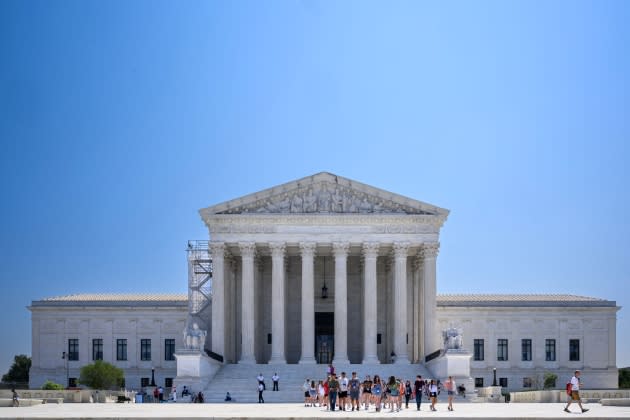The Supreme Court Actually Upheld the Voting Rights Act for Once

After a decade of steadily chipping away at the Voting Rights Act, the Supreme Court actually upheld a piece of the landmark civil rights legislation on Thursday, ruling that Alabama had diluted the power of Black voters in the state.
The case concerned Alabama’s new congressional district map, which was drawn after the 2020 census — and actually wasn’t much different than the map it had throughout the 2010s. The state was split into seven districts, six of which were majority white and reliably voted for Republican representatives, while the last was majority Black and reliably voted for Democratic representatives. This skewed the state’s representation disproportionately, as 27 percent of Alabama’s voting-age population is Black.
More from Rolling Stone
Sen. Whitehouse: Supreme Court Justices Are in a 'Fact-Free,' 'Ethics-Free Zone'
Supreme Court Slashes EPA's Ability to Regulate Water Pollution
Music Groups Call Supreme Court Ruling in Warhol Case a 'Massive Victory' For The Business
Civil and voting rights advocates challenged the new map in court under Section 2 of the 1965 Voting Rights Act, which prohibits any voting procedure (in this case, redistricting) that “results in a denial or abridgment of the right of any citizen of the United States to vote on account of race.” That occurs, the law adds, when minority groups “have less opportunity than other members of the electorate to participate in the political process and elect representatives of their choice.”
As it turns out, the Alabama map proved too flagrant in this regard even for conservative-packed courts. In Jan. 2022, a three-judge panel at the Federal District Court in Birmingham — which included two judges appointed by Donald Trump — unanimously ruled that the Alabama state legislature should’ve made a second district “in which Black voters either comprise a voting-age majority or something quite close to it.”
That decision was appealed and in Feb. 2022 the Supreme Court did vote 5-4 (with Chief Justice John Roberts joining the three liberal judges in the minority) to temporarily stay the district court’s ruling and keep the map in place for the 2022 midterm elections. This time around, Brett Kavanaugh joined Roberts, Sonia Sotomayer, Elena Kagan, and Ketanji Brown Jackson in upholding the original decision to throw out the map.
Roberts wrote the decision in the case, saying: “A district is not equally open, in other words, when minority voters face – unlike their majority peers – bloc voting along racial lines, arising against the backdrop of substantial racial discrimination within the State, that renders a minority vote unequal to a vote by a nonminority voter.”
But Roberts — who, lest we forget, wrote the infamous Shelby v. Holder decision gutting the Voting Rights Act 10 years ago — also appeared to extend something of an olive branch to the four conservative judges he voted against this time. He insisted this opinion “does not diminish or disregard the concern” that Section 2 of the VRA “may impermissibly elevate race in the allocation of political power within the states.” That potentially leaves room to further chip away at Section 2, which the Supreme Court began doing in 2021 with a decision that curbed the ability of minority groups to challenge voting restrictions.
Still, the decision marked a rare victory for voting rights advocates, and Alabama’s lone Black and Democratic congresswoman, Terri Sewell, celebrated it during an interview with CNN.
“I’m so happy that the justices saw the truth in the fact that that represents voter dilution and it’s black voter dilution,” she said, adding: “Everyone’s looking at this decision and I think that it will have a ripple effect, a positive ripple effect. It means that minority dilution is not going to be tolerated by the Supreme Court or by any court in the land and that is a huge victory.”
Best of Rolling Stone

 Yahoo Sports
Yahoo Sports 